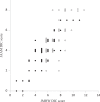Impact of Antithrombin Supplementation and Concomitant Anticoagulation Therapy in Pediatric Patients With Disseminated Intravascular Coagulation
- PMID: 30836769
- PMCID: PMC6714941
- DOI: 10.1177/1076029619834350
Impact of Antithrombin Supplementation and Concomitant Anticoagulation Therapy in Pediatric Patients With Disseminated Intravascular Coagulation
Abstract
We aimed to evaluate the efficacy and safety of antithrombin (AT) supplementation and concomitant anticoagulation therapy in 65 children who met the Japanese Ministry of Health and Welfare (JMHW) disseminated intravascular coagulation (DIC) criteria and had received AT concentrate and/or other concomitant anticoagulants. The primary efficacy end point was to determine standardized mortality ratio (SMR). The secondary efficacy end points were DIC resolution rate and pediatric sequential organ failure assessment (pSOFA) score on day 3. The 28-day mortality rate was 6.8%; SMR was 0.55. Disseminated intravascular coagulation resolution rate on day 3 was 54.5%. The JMHW DIC scores at day 0 ( P = .005) and pSOFA scores at day 3 ( P = .018) were significantly lower in patients with resolution of DIC than in those without resolution of DIC. The target cutoff value for JMHW DIC score on day 0 was 6. No bleeding-related adverse events were associated with AT administration. In children with DIC, AT supplementation and concomitant anticoagulation therapy can be safely used as initial treatment when JMHW DIC score is 6; it may improve DIC resolution, organ failure, and mortality rates.
Keywords: JAAM DIC criteria; JMHW DIC criteria; antithrombin; children; disseminated intravascular coagulation.
Conflict of interest statement
Figures


Similar articles
-
A randomized, controlled, multicenter trial of the effects of antithrombin on disseminated intravascular coagulation in patients with sepsis.Crit Care. 2013 Dec 16;17(6):R297. doi: 10.1186/cc13163. Crit Care. 2013. PMID: 24342495 Free PMC article. Clinical Trial.
-
A multicenter, prospective validation of disseminated intravascular coagulation diagnostic criteria for critically ill patients: comparing current criteria.Crit Care Med. 2006 Mar;34(3):625-31. doi: 10.1097/01.ccm.0000202209.42491.38. Crit Care Med. 2006. PMID: 16521260
-
Comparison of Protective Effects of Recombinant Antithrombin Gamma and Plasma-Derived Antithrombin on Sepsis-Induced Disseminated Intravascular Coagulation and Multiple Organ Failure.Clin Appl Thromb Hemost. 2020 Jan-Dec;26:1076029620981630. doi: 10.1177/1076029620981630. Clin Appl Thromb Hemost. 2020. PMID: 33332196 Free PMC article.
-
Present and future of anticoagulant therapy using antithrombin and thrombomodulin for sepsis-associated disseminated intravascular coagulation: a perspective from Japan.Int J Hematol. 2016 Mar;103(3):253-61. doi: 10.1007/s12185-015-1904-z. Epub 2015 Nov 20. Int J Hematol. 2016. PMID: 26588929 Review.
-
Anticoagulant Therapy for Disseminated Intravascular Coagulation After Gastrointestinal Surgery.Anticancer Res. 2019 Jan;39(1):25-31. doi: 10.21873/anticanres.13076. Anticancer Res. 2019. PMID: 30591437 Review.
Cited by
-
Developments in pediatrics in 2020: choices in allergy, autoinflammatory disorders, critical care, endocrinology, genetics, infectious diseases, microbiota, neonatology, neurology, nutrition, ortopedics, respiratory tract illnesses and rheumatology.Ital J Pediatr. 2021 Dec 7;47(1):232. doi: 10.1186/s13052-021-01184-4. Ital J Pediatr. 2021. PMID: 34876198 Free PMC article. Review.
-
Diagnostic Scores and Treatment Options for Acute Disseminated Intravascular Coagulation in Children.Cureus. 2021 Sep 3;13(9):e17682. doi: 10.7759/cureus.17682. eCollection 2021 Sep. Cureus. 2021. PMID: 34513536 Free PMC article. Review.
References
-
- Levi M, Ten Cate H. Disseminated intravascular coagulation. N Engl J Med. 1999;341(8):586–592. - PubMed
-
- Levi M. Disseminated intravascular coagulation. Crit Care Med. 2007;35(9):2191–2195. - PubMed
-
- Gando S, Saitoh D, Ogura H, et al. Natural history of disseminated intravascular coagulation diagnosed based on the newly established diagnostic criteria for critically ill patients: results of a multicenter, prospective survey. Crit Care Med. 2008;36(1):145–150. - PubMed
-
- Wada H, Wakita Y, Nakase T, et al. Outcome prediction of disseminated intravascular coagulation in relation to the score when treatment was begun. Thromb Haemost. 1995;74(3):848–852. - PubMed
-
- Gando S, Iba T, Eguchi Y, et al. A multicenter, prospective validation of disseminated intravascular coagulation diagnostic criteria for critically ill patients: comparing current criteria. Crit Care Med. 2006;34(3):625–631. - PubMed
MeSH terms
Substances
LinkOut - more resources
Full Text Sources
Miscellaneous

